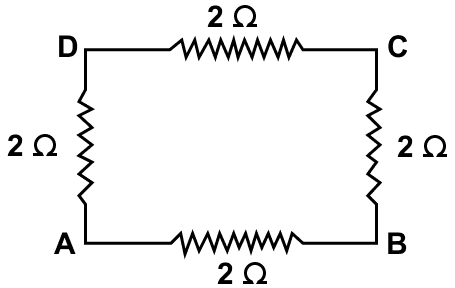Physics
Two resistors of 4.0 Ω and 6.0 Ω are connected (a) in series, (b) in parallel, with a battery of 6.0 V and negligible internal resistance. For each case draw a circuit diagram and calculate the current through the battery.
Current Electricity
12 Likes
Answer
(a) Circuit diagram showing two resistors of 4.0 Ω and 6.0 Ω connected in series with a battery of 6.0 V and negligible internal resistance is shown below:

Given,
Two resistors of 4 Ω and 6 Ω are connected in series. If the equivalent resistance of this part is R's then
R's = (4 + 6) Ω = 10 Ω
Potential Difference V = 6 V
Current I = ?
From Ohm's law
V = IR
Substituting the values in the formula above, we get,
6 = I x 10
⇒ I = 6 / 10 = 0.6 A
Hence, in series, current through the battery = 0.6 A
(b) Circuit diagram showing two resistors of 4.0 Ω and 6.0 Ω connected in parallel with a battery of 6.0 V and negligible internal resistance is shown below:

Given,
Two resistors of 4 Ω and 6 Ω are connected in parallel. If the equivalent resistance of this part is Rp then
Potential Difference V = 6 V
Current I = ?
From Ohm's law
V = IR
Substituting the values in the formula above, we get,
6 = I x 2.4 ⇒ I = 6 / 2.4 = 2.5 A
Hence, in parallel, current through the battery = 2.5 A
Answered By
6 Likes
Related Questions
Two resistors of resistance 2 Ω and 3 Ω are connected in parallel to a cell to draw 0.5 A current from the cell.
(a) Draw a labelled diagram of the arrangement.
(b) Calculate the current in each resistor.
In the network shown in figure, calculate the equivalent resistance between the points (a) A and B (b) A and C

A resistor of 6 Ω is connected in series with another resistor of 4 Ω. A potential difference of 20 V is applied across the combination. Calculate (a) the current in the circuit and (b) potential difference across the 6 Ω resistor.
Five resistors, each of 3 ohm, are connected as shown in figure. Calculate the resistance (a) between the points P and Q, and (b) between the points X and Y.
